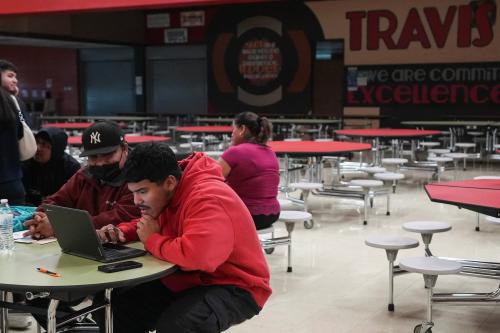This piece summarizes our event “Understanding and addressing gender, class, and racial disparities in college enrollment.” The full recording of the event is available here.
On January 23, the Brookings Center on Children and Families hosted an event where leading education experts discussed the factors that contribute to college enrollment disparities and ways to improve access to higher education.
First, Sarah Reber, senior fellow in the Economic Studies program at Brookings, presented findings from her new report with Ember Smith. Although college enrollment rates vary significantly by socio-economic status (SES), gender, and race or ethnicity, they find that disparities are much smaller among students with similar academic preparation. Reber suggests that policymakers interested in addressing college enrollment gaps should address disparities in academic preparation, which are influenced by opportunities both in and out of school.
Following Reber’s presentation, Katharine Meyer, a fellow in the Brookings Brown Center on Education Policy, moderated a conversation with three education researchers. Panelists addressed obstacles to educational opportunity, approaches to improving K-12 education, changes in college admissions policy, and what policymakers and researchers should focus on going forward.
Preparing for college: K-12 obstacles and interventions
A student’s educational trajectory is largely determined before they apply to college, and admissions-focused interventions alone are not sufficient to address disparities in higher education, panelists agreed. They considered obstacles students face in successfully transitioning to college and what K-12 policymakers and educators might do to address them.
For one, panelists discussed, educators should work to create inclusive educational environments. As Sade Bonilla, Assistant Professor at the University of Pennsylvania, pointed out, many students of color, students from immigrant families, and students from low-income families are culturally underrepresented in their schools’ curricula and textbooks. Richard Reeves, senior fellow in the Economic Studies program at Brookings, also argued that boys may be harmed by the lack of men in the teaching workforce. Representation in schools — especially with increasingly diverse student bodies, they added — promotes student engagement and sense of belonging at school. It is also actionable: Bonilla’s work shows that students who took an ethnic studies course in ninth grade were more likely to graduate high school, had higher rates of attendance, and were more likely to enroll in college.
Panelists also agreed that policymakers should be cautious about one-size-fits-all approaches to increasing college enrollment, especially those focused specifically on increasing advanced course enrollment (one of the measures Reber and Smith use to measure academic preparation in their report). Lindsay Page, associate professor at Brown University, described her recent review of the economic literature on addressing non-financial barriers to college access. One of her primary takeaways is that substantially increasing enrollment in advanced courses in high school is unlikely to improve students’ educational outcomes. In large part, that’s because students who are inadequately prepared may be discouraged if they lack support to succeed in those courses.
Panelists discussed earlier-in-school interventions to keep students on track. Page pointed to evidence from a program that assigns “high-achieving” students, determined by a standardized test in elementary school, to a program with high value-add teachers and advanced curricula. Participating students — especially students of color — had higher high school graduation and college enrollment rates years later. Bonilla added that regardless of whether courses are considered “advanced” or not, educators should prepare students for college by emphasizing critical thinking, reading, and writing across the curriculum. The panelists agreed that the disparities in academic preparation start early and compound over time. Education is a cumulative process, and by the time students apply to college, Page said, the “cake is already baked.” Reeves cautioned against using this type of evidence to let colleges (or K-12 schools and policymakers) off the hook: “The cake is always baked earlier. If you go to the high schools, they’ll say … look at the middle schools. You go into the middle schools, they’ll say the cake’s baked in elementary school.” The panelists agreed that policymakers and educators need to take responsibility for addressing education gaps at each stage of the process.
Panelists highlighted research showing that it is not too late to intervene in high school. Page pointed to evidence that dual enrollment programs, which allow students to enroll in community college courses while in high school, have been quite successful in increasing educational attainment. In addition to providing students with the opportunity to engage in actual college courses, Page called attention to a key element of many successful programs: high-quality and accessible guidance counsellors. Reeves also pointed to the success of vocational education programs that have a strong connection with employers.
Test-optional policies, the Supreme Court, and college resources
Meyer asked the panelists to comment on how ongoing shifts in admissions policy are influencing opportunity in higher education and what we might expect in the future.
Many colleges have made standardized admissions tests (SAT or ACT) optional; some have gone further, eliminating consideration of test scores from the process altogether. Reeves predicted the test-optional trend will continue and that renewed attention to admissions might put pressure on colleges to eliminate legacy preferences. Page added that practices for admitting athletes might also be a focus of the “reckoning on college admissions.”
The panelists were skeptical that the move away from standardized tests will have a major impact on the SES and racial enrollment disparities noted in Reber and Smith’s report. This is largely because, as the panel pointed out, test scores capture educational inequality also reflected in other measures reported on college applications. Reeves pointed to evidence suggesting that test-optional policies benefit girls relative to boys, which would widen the gender gap somewhat. Test-optional policies further complicate the already-complex college admissions process. As Meyer put it, the “gamesmanship” necessary to navigate decisions like whether to submit test scores benefits students whose families or schools have resources to help. “Complexity is the friend of the privileged,” Reeves remarked. Without exam scores, Bonilla explained, admissions officers will rely on other signals that reflect similar differences in opportunity.
As Meyer described, the Supreme Court’s expected decisions in two cases related to affirmative action policies would considerably limit colleges’ ability to consider race in admissions. Page suggested that the shift will particularly impact public flagship universities. And the change is likely to affect racial disparities in higher education. Bonilla pointed to California Proposition 209 — which prohibited public institutions from considering race, sex, or ethnicity in admissions — as a bellwether for U.S. college enrollment patterns in a world without affirmative action. She explained that the California policy caused a reallocation of students in the postsecondary system: Black and Hispanic students shifted from selective to less-selective universities, while Asian students became more likely to attend selective institutions. A national move away from considering race in admissions, Bonilla anticipates, will reduce Black and Hispanic students’ access to well-resourced institutions.
Community colleges and less-selective four-year colleges play an important role in supporting social mobility, the panel explained, while selective and elite colleges often garner disproportionate attention in public discussions. Community colleges and less-selective four-years serve many more students from disadvantaged backgrounds but have fewer resources than selective and elite colleges. “We spend the most money on the most advantaged students, and the least … on students who could probably use a lot more support,” Bonilla stressed. The panel agreed, with Page expressing particular concern about for-profit institutions saddling students with debt and failing to provide adequate training or credentials.
What next?
To close, Meyer asked each of the panelists to comment on their top policy and research priorities for issues related to college enrollment. Drawing on themes in his latest book Of Boys and Men, Reeves called for more research on the obstacles facing boys, particularly low-income boys and boys of color, in education. Page supported renewed investment in guidance counseling for students and their families. Bonilla emphasized the need to understand obstacles to community college completion and advocated for continued investment in making K-12 schools inclusive for marginalized communities: “Students have potential, and we want them to realize that potential.”
The Brookings Institution is financed through the support of a diverse array of foundations, corporations, governments, individuals, as well as an endowment. A list of donors can be found in our annual reports published online here. The findings, interpretations, and conclusions in this report are solely those of its author(s) and are not influenced by any donation.






Commentary
Examining college enrollment gaps: A discussion with leading scholars
February 3, 2023